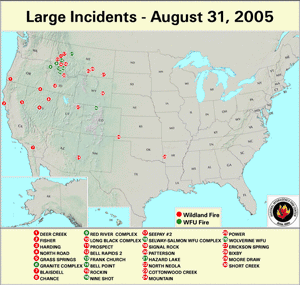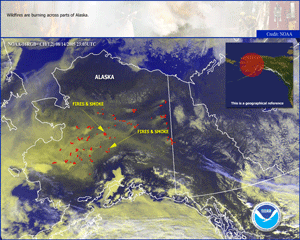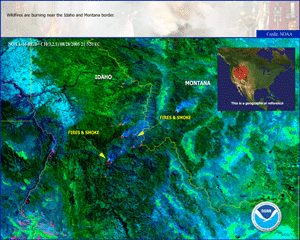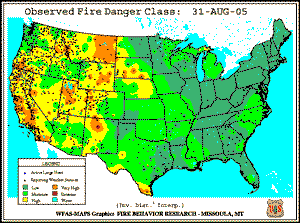Wildfire activity continued across the U.S. during August, as numerous large fires burned in Alaska, the Northern Rockies, and Columbia Plateau regions. As reported by the National Interagency Fire Center, over 7.4 million acres had burned across the U.S. by the end of the month, ranking the 2005 season in the top five since 1960 for acres burned. The 2000 fire season is currently the record year for the U.S. with over 8.4 million acres burned.
Active fires and burned areas can be seen on the 31 August 2005 MODIS fire detections map, which shows the locations and extent of wildland fire activity in the western U.S. through the month of August (over 3.6 million acres have burned in the contiguous U.S. so far this year). Numerous large fires also burned across central Alaska during August, where over 3.8 million acres have burned this year as of August 31st.
Drier than normal conditions during the summer months have contributed to extremely low dead fuel moisture levels across the western U.S. and High Plains. Fine fuels (i.e., 10–hour fuels) remained extremely dry across the Great Basin in August. In addition, extremely dry fuel conditions have also developed across northern California and the interior Pacific Northwest over the past month.
| As of August 31, 2005 | Nationwide Number of Fires | Nationwide Number of Acres Burned |
|---|---|---|
| 2005 | 45,804 | 7,447,188 |
| 2004 | 55,044 | 7,381,166 |
| 2003 | 44,823 | 2,695,156 |
| 10–year Average | 62,464 | 4,202,249 |
Medium to larger fuels were also extremely dry at the end of August, especially across California, southern Idaho and the Great Basin (i.e., the August 31st 100–hr and August 31st 1000–hr fuel moistures).
The Keetch–Byram Drought Index (KBDI), a widely used index for fire risk, had the largest potential for wildland fire activity in the contiguous U.S. at the end of August across parts of northern California and coastal Oregon, along with a large area of the southern Plains and Gulf Coast region. For further information on drought conditions go to the August drought summary page for the U.S.
The potential for large fire development and spreading was evident in the fire danger classification on 31 August 2005. By the end of this past month, the fire danger classification remained high to very high across parts of the West.
 NOAA's National Centers for Environmental Information
NOAA's National Centers for Environmental Information



